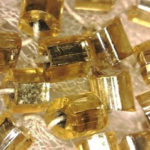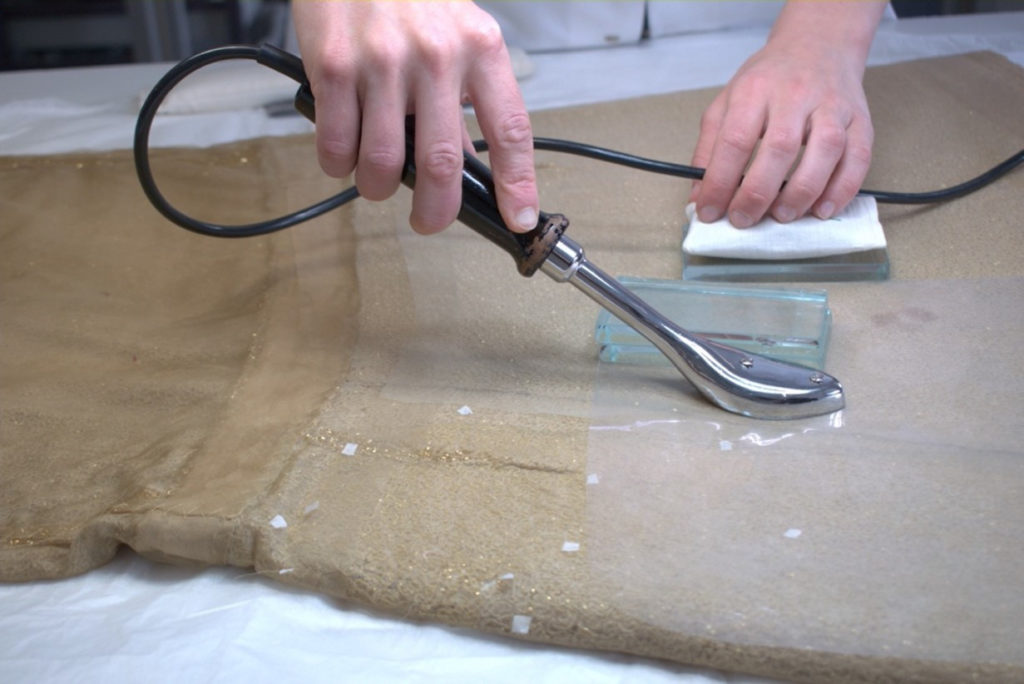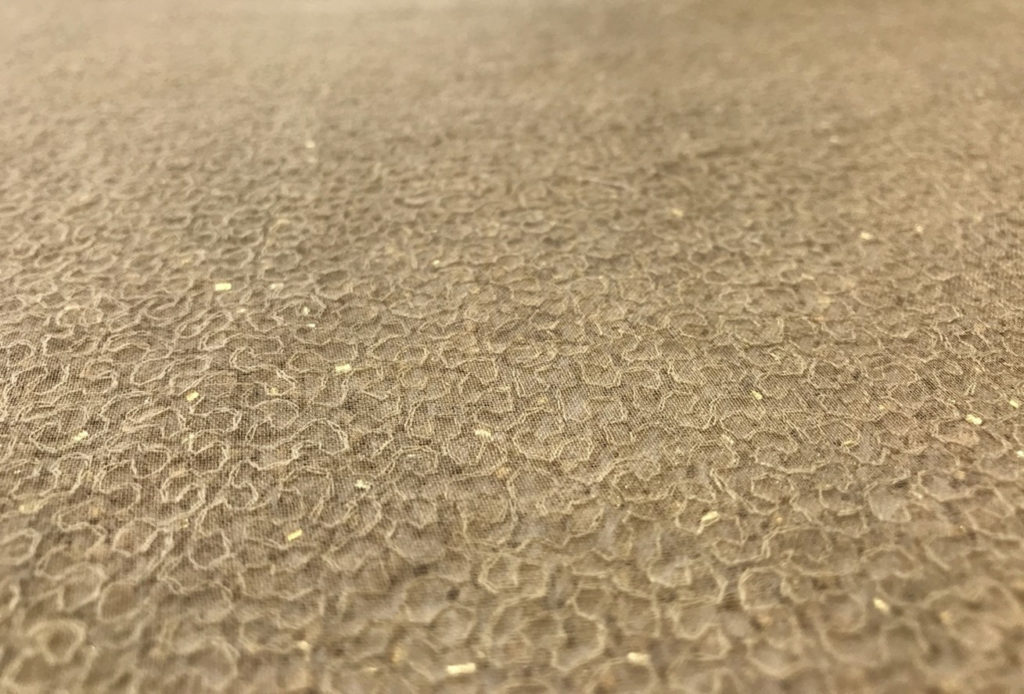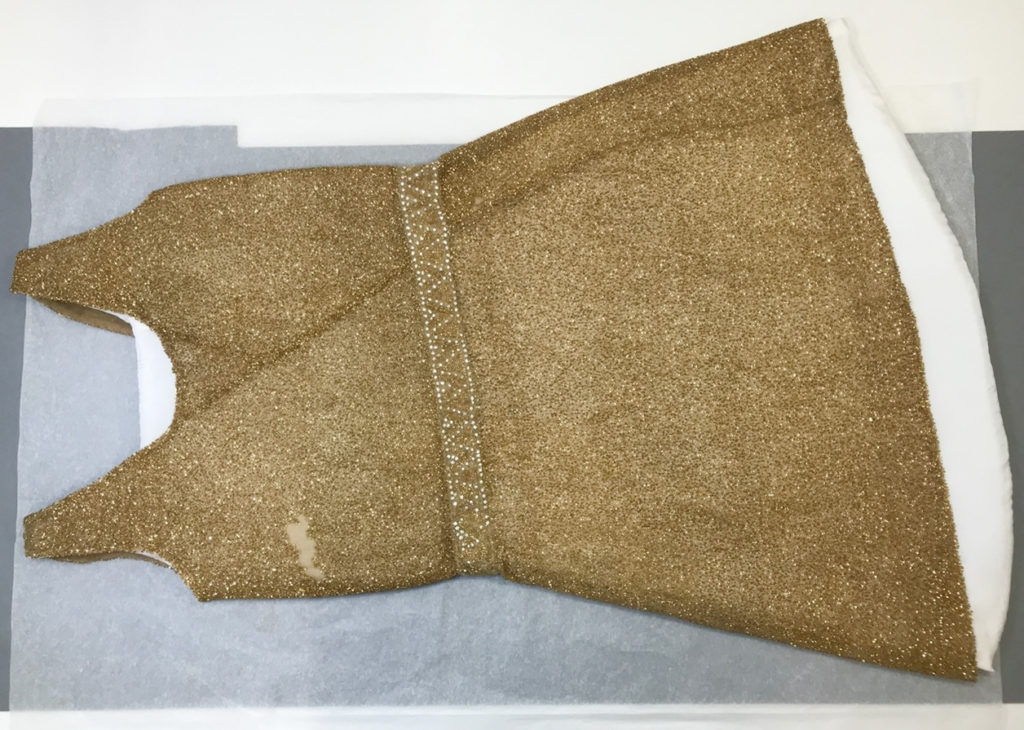
by Nicole Giacomantonio, recent graduate.
I was very fortunate to spend the last month at the Kelvin Centre for Conservation and Cultural Heritage Research to undertake the final stage of treatment on a 1920s’ gold beaded dress belonging to Glasgow Museums.
The dress (E.1973.62.b) was originally purchased from Murielle’s of Sauchiehall St in Glasgow and is one of several in Glasgow Museums‘ collection. Founded in 1910 by Muriel Hymans, the up-market dressmaker and boutique stocked the latest fashions from Paris.[1] As the The Glasgow Story explains,
” Many of the evening dresses stocked by Murielle’s in the 1920s were beautifully embellished with beadwork and embroidery, having come directly from Paris. In 1926 the magazine Scottish Field noted that “never have such dance frocks been so seductive. The straight slim bodices, slim hips and then the swirl of soft material which hangs around the knees and sways with the body as it tangos and foxtrots…””
This dress had been in the care of MPhil Textile Conservation students for several years and was flagged as a high priority object for conservation during the Centre’s recent move to Kelvin Hall.

Front view of the beaded dress before conservation.
Photo © CSG CIC Glasgow Museums Collection and University of Glasgow, 2021. Taken by Kathleen Martin, treatment phase 1.
Back view (R) of the beaded dress before conservation.
Photo © CSG CIC Glasgow Museums Collection and University of Glasgow, 2021. Taken by Kathleen Martin, treatment phase 1.
The skirt sits at knee length and has an asymmetrical hem. The ground fabric is a beige silk crêpe georgette in a plain weave with glass bead decoration attached by chain stitches in a technique called tambour beading. Over time, the weight of the beads and the heavy stitching that held them had encouraged the formation of numerous small holes and tears in the fine silk ground as well as breakage in the tambour work chain stitch and bead loss. Movement and handling the dress had become very difficult, as it risked causing further fabric tearing and bead loss.

USB microscope image (Dino-Lite) at x200 magnification of beads attached to silk ground fabric. Photo © CSG CIC Glasgow Museums Collection and University of Glasgow, 2021. Taken by Charlotte Cameron, treatment phase 2 
Image of overall bead coverage. Photo © CSG CIC Glasgow Museums Collection and University of Glasgow, 2021. Taken by Charlotte Cameron, treatment phase 2
The aim of the treatment was to improve structural stability and appearance of the dress, with the ultimate goal of enabling Glasgow Museums to safely display it. Previous treatments saw the successful conservation of the belt and bodice through adhesive support patches, protective linings, and stitched support. Additionally, support patches were applied in several areas of the skirt and along the bottom hem. However, the dress continued to show signs of inherent weakness. For the final stage of treatment, the fine silk ground fabric in the skirt required a full adhesive and stitched support to match that of the bodice and belt.
The support fabric was to be attached to the inside of the dress, meaning that the dress needed to be turned inside out. In order to prevent the beads from crushing together during the treatment, I made a silk cushion that could be inserted between the layers of skirt. The cushion also provided an even and forgiving surface for the application of slight pressure to during the treatment.
I used a length of dyed and adhesive cast silk crepeline (15% 1:1 solution of Lascaux 303HV:498 HV) prepared by Beth Gillions in phase 3 of this treatment to support the skirt. The adhesive was slowly reactivated using a heated spatula, following which I applied lines of support stitching using 2 ply silk thread to reinforce the adhesive bond and to evenly distribute the weight of the skirt across the support. The localized support patches previously applied were removed as I worked to avoid creating fabric bulk and strain in fragile areas.
When the full adhesive and stitched support was completed, the dress was turned right side out again and I applied nylon net over areas where there was risk of further damage. These were primarily areas of substantial fibre damage and where beading had detached, had been lost, or were at risk of falling away. In an area of bead loss on the bodice, I added lines of couching stitches with 2 ply silk thread to secure the broken ground fabric to the support. This area was also covered with net in order to protect it from future loss.
The area of bead loss before (L) and after (R) couching stitches and application of protective net. Photo © CSG CIC Glasgow Museums Collection and University of Glasgow, 2021. Taken by Nicole Giacomantonio
I finished the treatment by creating a silk cushion in the shape of the bodice, similar to that which I made for the skirt at the start of the treatment. The cushions are internal supports for the dress in storage. The two cushions could be separated slightly at the mid-point of the dress which would allow for the dress to be folded just above the belt line where the dress was most robust.


The dress was packed away for its return to Glasgow Museums after many years of care. This treatment was a continuation of 3 previous phases of treatment done by Kathleen Martin (2018), Charlotte Cameron (2019) and Beth Gillions (2020). My process and decisions were heavily informed by the excellent research, trials and documentation carried out by my predecessors. Their fine conservation work paved the way for my success in this the fourth and final phase of this treatment.
I am grateful to have been able to undertake this treatment and was able to do so thanks to the generous support of the Anna Plowden/ Clothworkers’ Foundation through a Continuing Professional Development Grant, and thanks to support I received from CTC tutors Karen Thompson and Sarah Foskett. Thank you!
[1] Glasgow Museums, Collections Navigator, http://collections.glasgowmuseums.com/mwebcgi/mweb?request=record;id=62596;type=701, accessed 14 June, 2021.








A fascinating and engaging article, Nicole, describing such an involved adhesive treatment to such a beautiful piece: beading does create so much difficulty long-term in terms of weight damage. I was enthralled to learn your specific process for this treatment and look forward to viewing the dress when it is installed!